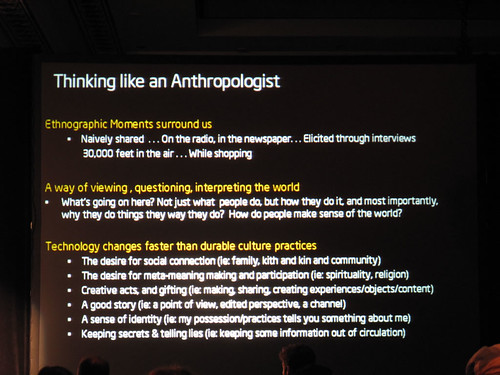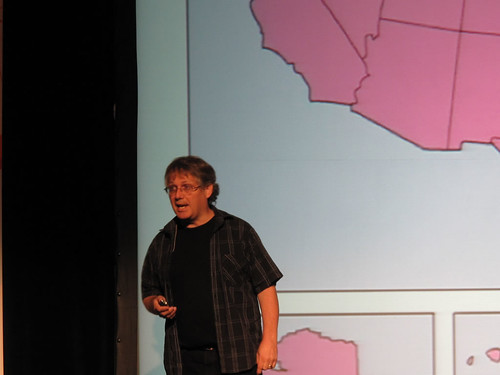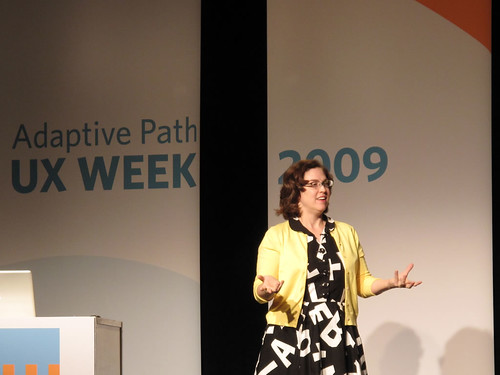UXweek Day 2 - Expression
From here on out, the speakers were a bit more unconventional, with more emphasis on the human interaction and experience side of things.
Sarah Jones
Sarah is a Tony-award winning playwright, whose forte is giving a multi-character one-woman monologue. She delivered her hilarious and spot-on impressions of a Jewish woman, a rapid-talking Dominican American woman, and an African-American youth, all the characters giving their own takes on what UI and UX meant to them.
See her TED talk here: http://www.ted.com/talks/sarah_jones_as_a_one_woman_global_village.html
The application of her talk with UI and UX was in her process of “getting into character” and how that mirrors the persona-building and role-playing design process. Sarah described how she spent the majority of her time prepping in character–one story she shared was how she once prepared for the role of a homeless woman by actually dressing like one and sitting outside her theater and experiencing the fear and insecurity the woman must have felt.
- The work of UX affects the confidence of users
- UX bridges the gap between the haves and have-nots
- Can’t forget that these are personal experiences
Alexandra Zafiroglu - Intel - “Thinking Ethnographically about Technology”
Alexandra is a anthropologist at Intel assigned to study the habits of people and technology. She highlighted four interactions: one in Japan, one in Sweden, one in the USA and one in India.
Ethnographic moments surround us. Way of viewing, questioning, interpreting the world: what, why, how, etc.
Durable culture practices:
- Social connection
- meta-meaning (spirituality, religion)
- creative acts
- a story
- sense of identity
- secrets & lies
Tech changes faster than these!
Five (four?) ethnographic moments
1. Japan: Zafiroglu tasked one familiy to record one TV-watching moment with a Flip camcorder. Team received a clip of the father sprawled on the floor of a tiny room, the daughter giving him a massage.
Insights into:
- body mechanics
- sleeping practices
- affection & love
- filial piety
2. Sweden:
“yuppie teddy bear aphasia”:
- Term for burnout when the world becomes overly connected, wired.
- public expression of fear and distrust
- critique of free-market capitalism
- gendered protest: way for women to critique
- dealing with the death of socialist government
3. USA
Family fights over who gets to record what on the DVR. Mom wakes up early to delete shows that boys record, boys wake up earlier, etc.
Insights into:
- responsibility: family tensions, tech tensions
- thwarts mothering
- necessitates responsibility
- encourages autonomy, ingenuity
4. India
Man owns cell phone business, also a place where he loads up forbidden content onto customers’ phones. Also runs a PlayStation arcade.
Insights into:
- Trust and community
- Gendered play (men and boys)
- Independence
I also got a chance to chat briefly with Alexandra while in line for lunch. Turns out her path to joining the tech industry through her Ph.D. has been a bit unconventional (after all, how many anthropologists get hired in the industry? These days, it’s a growing number.) Kudos to Intel for putting in the research to develop technologies that mold to culture practices.
Scott McCloud: “Experiencing Comics”
Scott is a graphic artist/illustrator who gave this really tight presentation on how the comic world deals with issues of time and space and where graphic storytelling is going in the future.
- “I’m a storyteller.”
- Comics is a kind of temporal map, a call & response between artist and reader
- Digital comics are a different beast – CDROMs were the center of experimentation in the 90’s.
In comics, space = time
- Form affects storytelling.
- Typical comic strip: vertical layout. This is not the way we were designed to see. Shows horizontal frame–we should be displaying comics horizontally?
- How can we break out of the print format. Adapt to Web.
- Rich digital comics: Continuous space metaphor, deep-zoom.
- “Desire” as a motivator for stories. Look at stories around you. Note how a story is told when a character has a desire for something: Dorothy, to go home. The Little Mermaid, to be human, etc.
Erin McKean - wordnik.com - “How Words Work”
- English is broken: expectations of how it’s supposed to work and how it actually works are different.
- Broken phrases: “Speed enforced by aircraft”, “slow–children @ play”, “can you pass the salt?”
- New words: “Fail”, “teh internets”
- We can choose to fight these new phrases or accept them. The right thing to do is accept them.
- How wordnik is designed: instead of dictionary experience (in, find def’n, out), refine as an exploratory experience.
- See full usage in texts, Twitter, Flickr photos.
Seminar Day 2: Rapid Prototyping w/ Kate Rutter, Adaptive Path
How to (1) sketch/explore ideas, (2) bring lots of ideas together, (3) share & iterate with team.
Sketching: not about being good or bad, it’s about communicating an idea.
- Use markers for emphasis, line weights. Not a pencil.
- Label your mockups/prototypes often.
- Good to make mind go free
- Take several ideas and narrow down
- Use 6-up template
- Use 1-up template
Tips to get creative:
- “Use your words”: Acquire a big stash of words associated with UI (“bookshelves”, “tags”, “collapsible”, “carousel”, “quicklook”, …) and then try them out on your solution.
- Inspiration: collect samples of interesting design work that inspires you and go back to it often.
- Use dimensions to expand conceptual model.
- Line weight draws attention to
- Shading draws attention away
- Labels are important.
Sketchboards: A way to prototype as a group.
- Get large sheet of paper
- Give it some structure (divide into functional sections)
- Add inputs
- Anything that drives thinking
- Requirements
- Personas
Drafting dots hold papers on a wall and can be used to affix sketches to boards.
Thinking top-down
A healthy sketchboard has depth (curiosity) and breadth (completeness) Organize sketches breadthwise into modules, components Then expand your ideas depthwise.
How to do a review session.
- Email people beforehand, prepare them.
- Use walls where people can come around your designs.
- Tailor design for who is in the room
- Pass the pen around and ask others to draw
- Refer back to inputs
- Black hat sessions - have folks play “devil’s advocate” and ask questions, critique.
Asking questions to drive design discussion
- Open-ended questions @ beginning leads to conversations
- Closed-ended questions @ end lead to decisions
Remember that sketchboards are just jumping-off points.
Design sprints
Quickly generate wireframes and comps from ideas generated from sketchboard. A possible weeklong sprint:
- Monday: braindump, start sketches
- Tuesday: assemble sketchboards, share and review sketchboards
- Wed: Create higher-fidelity designs.
- Thursday: Share hi-fi designs, refine.
- Fri: Refine some more, complete.
Remember to take breaks!



